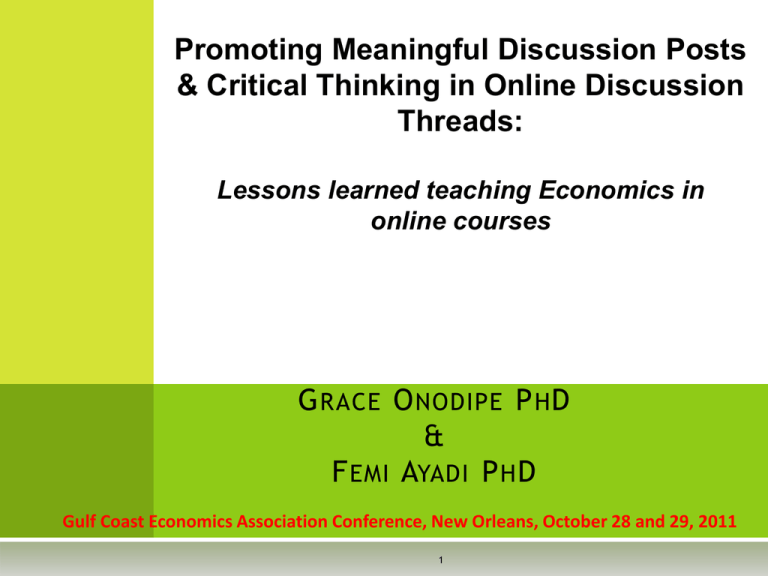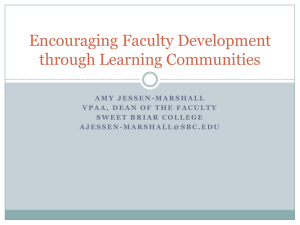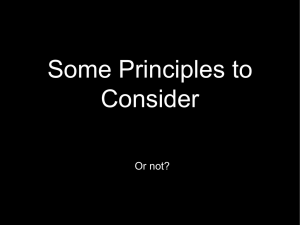Type of Student Posts
advertisement

Promoting Meaningful Discussion Posts & Critical Thinking in Online Discussion Threads: Lessons learned teaching Economics in online courses G RACE O NODIPE P H D & F EMI AYADI P H D Gulf Coast Economics Association Conference, New Orleans, October 28 and 29, 2011 1 O NLINE ENROLLMENT IS GROWING ! 2 35% Online Enrollment as a % of Total Enrollment 30% 29% 25% 20% 19% 15% 10% 12% 5% 0% 2003 2004 2005 2006 2007 2008 2009 Sloan Foundation, 2010 INTRODUCTION 3 Online courses have become very popular Online discussions are a core component of asynchronous online learning Yet, much of online discussions are unstructured and ineffective B ENEFITS 4 OF A SYNCHRONOUS DISCUSSION THREADS Enables groups separated in time and space to engage in active production of shared knowledge Equal Opportunity to participate Students maintain a community of learners when and where they choose Students have more time to think about topic, and read what others have contributed Ability to support their argument with scholarly work Opportunity to develop critical thinking skills (Olt, 2009) A SYNCHRONOUS ONLINE 5 DISCUSSION THREAD Can work very well in Online Principles of Economics Courses An avenue for students to apply course content to real life events Work/Life experience Current news events Personal decision-making Demonstrate understanding of newly learned Economics Vocabulary L ITERATURE R EVIEW 6 Students discuss at their convenience, encourages reflective learning (Gilbert, 2005) Students participate at their own pace (Tiene, 2000) Equal opportunity to participate (Vonderwall et al, 2007) Online discussion can go beyond simple exchange of information to higher level of cognitive thinking (Garrison and Cleveland-Innes, 2005) Students need to be aware of characteristics of acceptable responses to cultivate critical thinking (Bai, 2009) L ITERATURE R EVIEW 7 Facilitated discourse is critical to creating a community of inquiry (Anderson, 2004; Easston, 2003; Bullen, 1998). Questions and thought coexist. Good questions must be sound in learning theory (Hunkins, 1989) Knowledge of evaluation criteria increases quality of students participation in online discussions (Gilbert and Dabbagh, 2005; Schenker, Arnold and Kuo, 2007) Unlike wine, critical thinking does not improve as we age, nor does it increase as we accumulate more information (Glaser, 1941); therefore, our job is to increase students’ critical thinking with deliberate instruction. 8 R ESEARCH Q UESTIONS What factors promote meaningful discussion and support critical thinking in online discussion threads? 1. Does using more specific and meaningful discussion questions influence critical thinking in online discussion? 2. Does placing more structure on Facilitator Questions influence student participation in online discussions? 3. Does including a “By Wednesday” Requirement increase participation in online discussions? H YPOTHESES 9 1. Increasing the structure of discussion board assignments increases frequency and quality of student posts Level of critical thinking in online discussion threads is greatly improved. 2. Improved Facilitator presence in the form of Comments and Questions increases substantive student posts H YPOTHESES 10 3. Having a “By Wednesday” Post requirement improves student posting pattern. Skews posting toward earlier in the week Allows for more interaction throughout the week M ETHODS 11 Content analysis and case study analysis methodology 2 Undergraduate Principles of Economics online courses (2008, 2011) Week 2 Discussion Thread Week 7 Discussion Thread CREST+ T EMPLATE 12 CREST+ template for creating good discussion questions (Akin & Neal, 2007) Cognitive Nature Reading Basis Experiential Element Style of Question Type of Question + 13 W HAT IS A MEANINGFUL POST ? Defines a key concept from the week’s material Asks for clarification of a difficult concept Answers another student’s or instructor’s question Relates relevant key concepts to work or life issues Respectfully disagrees with another student’s post Appropriately summarizes or refers the class to a textbook chapter or credible and useful Internet Source for further explanation of concepts, or Generally demonstrates that the student understands the key concept being addressed by the Core Learning Outcomes. 14 B LOOM ’ S TAXONOMY Bloom’s Definition Evaluation Analyze situation and make judgment Synthesis Going from component parts to the big picture Analysis Break down situation into component parts Application Apply knowledge and comprehension to a new situation Comprehension Demonstrate understanding of knowledge in own words Knowledge Lowest level of learning – regurgitation/memorization stage 15 B LOOM ’ S TAXONOMY } } Higher order thinking Lower levels of thinking 16 Coding Student Posts, Gilbert & Dabbagh, 2005 Code Name Definition MI Making Inferences Going beyond information given. Beyond comprehension, analysis, synthesis, evaluation-adding or constructing new knowledge AE Abstract Example Use of analogies, metaphors or philosophical interpretations to support one’s understanding of a concept or principles RW Real World Example Personal experience, professional/academic experiences. Providing examples that demonstrate the application of knowledge to a real word context PK Prior Knowledge Prior knowledge and outside resources, e.g. learner uses prior knowledge or outside resources to support a statement or an understanding CC Content Clarification Personal interpretation of content or content knowledge comprehension, e.g. paraphrasing concept or principles in one’s own words RC Reading Citation Citation of weekly readings, e.g. learner specifically cites article or chapter when making a point. NS Not Substantive Students post does not include any of the above, and does not relate to the week's learning objectives 17 C OMPARISON TO BLOOM ’ S Bloom’s Taxonomy Gilbert & Dabbagh Analysis, Synthesis, Evaluation MI AE Application RW PK Comprehension CC Knowledge Level RC 18 D ESCRIPTIVE STATISTICS 2008 Week 2 2011 Week 7 Week 2 Week 7 Number of Students 18 20 Male Female 10 8 10 10 Total Number of Student Responses 91 Average Number of Student Responses 5.22 Average Number of Substantive Student 3.11 Responses % Substantive 38% % of Posts in Higher Levels (RW to MI) 18% Average Time Spent on DB (minutes) 143 78 97 84 4.33 4.85 4.2 2.66 4.55 4.05 62% 94% 96% 8% 60% 60% 138 195 123 T YPE 19 OF S TUDENT P OSTS 60% 50% 50% 40% 33% 29% 30% 26% 20% 17% 17% 11% 10% 5% 4% 4% 3% 0% 1% 0% NS RC CC PK RW AE 1% MI 2008 2011 NS = Not Substantive LO = Lower Order Thinking (RC to PK) HO = Higher Order Thinking (RW to MI) 20 70% 62% 60% 60% 60% 54% 50% NS 38% 40% 37% 34% LO 30% 21% 20% 18% HO 8% 10% 6% 4% 0% 2008 (2) 2008 (7) 2011 (2) 2011 (7) B Y W EDNESDAY R EQUIREMENT 21 40% 35%34% 35% 31%30% 30% 25% 20% 24% By Wed 16% 15% 12% 2008 (2) 2008 (7) 15% By Wed + Substantive 10% 5% 0% 2011 (2) 2011 (7) 22 NS (Not Substantive) S AMPLE S TUDENT P OST Learning Objective for Week 2 : Demand and Supply “Speaking of kids, my 11 year old has been hounding me for using too much water. They are teaching the children in schools about water conservation. My kids are thinking more about how long their showers are and about leaving the water running while brushing their teeth.” 23 S AMPLE S TUDENT P OST RC (Reading Citation) “The law of demand states that when price drops, demand will rise or when price rises, the demand falls. About 3 years ago, the price of whole bean coffee was $12.50 per bag. Yesterday while at the grocery store the price dropped to $6.50 per bag. I bought 2 bags even though I am spending .50 cents more, I am receiving more of the product. I figured this was a pretty good deal considering the price difference over the course of 3 years. 3 years ago I would only purchase 1 bag of whole bean coffee because 2 bags would have been $25.00. The law of demand without even knowing it was a major factor when I decided to purchase the item. So I say stock up while you can...here is an article I found regarding coffee: http://www.inquisitr.com/152643/heavy-rain-affecting-coffee-prices/” 24 S AMPLE S TUDENT P OSTS CC Code - Content Clarification “A store that increases the price of its shoes from $50 to $68 is expected to see a change in quantity demanded not a change in demand because it is only a change in price that has occurred. This is essentially what the Law of Demand states. Some of the determinants that can cause a change in demand are determinants such as; consumer taste, income, price of related goods, consumer expectations, and number of buyer. ” S AMPLE S TUDENT P OST 25 PK Code - Prior Knowledge “ Two ways to decrease gasoline price are to decrease demand and increase off-shore drilling. I am for reducing the demand for gasoline. I am not for off shore drilling because the concerns for wild life are just too large a trade-off (recent major Gulf spill)…. Not to mention the cost of potential spills would end up causing billions in cleanup cost that would generate back to increase in production and there goes the cycle again... ” 26 S AMPLE S TUDENT P OST RW Code - Real World Examples “There are many stores that have very little marketing strategy outside of discounting the price of their products. Grocery stores do this all the time. I have seen people with a shopping cart full of Gatorade because it was 10 for $10. The mobs of people shopping the day after Thanksgiving and Christmas are excellent examples of that. ” 27 S AMPLE S TUDENT P OST AE Code - Abstract Example “As George Bush said while he was still president, America is addicted to oil. This statement has price inelasticity written all over it. I think that statement is true because even when price increases, how many of us cut back on our consumption of oil? ” 28 S AMPLE S TUDENT P OST MI Code - Making Inferences “If I am understanding the text so far, price elasticity and inflation/taxes are two different subjects. Price elasticity is the measure of change in quantity demanded for or supplied of a product. There is Price Elasticity of Demand and Price Elasticity of Supply. Inflation on the other hand is merely a rise (across the board) of most prices in the economy - which will affect demand and supply of products and resources, but inflation is not a measure like price elasticity is. Inflation and taxes are changes in prices, price elasticity measures how the market will now respond to those changes in prices .” 29 Sample Facilitator Questions/Posts Name Definition Examples Facilitator Initial Question (Experiential) Initial Discussion Questions posted by the Facilitator to get the discussion started (Sunday night or Monday) Think of a career, education, or personal, or family decision you made recently. Identify the opportunity cost involved with your decision. Thanksgiving is just around the corner and with it comes … Black Friday shopping! How many of you will go out in the cold and camp out at Best Buy as early as 1:00am to get that laptop for $150? Use the concept of Opportunity Cost to explain your decision making. 30 S AMPLE FACILITATOR Q UESTION Name Definition Example Type of Question: Follow Up Questions posted by the Facilitator Glad you brought up the idea of PRICE CEILING. Class, do you like to see a price ceiling set on Gasoline? Why? Why not? Class: What market structure would you classify online education industry? Go through the features of the different Market Structures to help you decide. Class: Please read the following article on Free Trade. After reading the article, comment on another student’s post and show how his/her arguments contrast the arguments outlined in the paper. 31 S AMPLE FACILITATOR Q UESTION Name Definition Examples Facilitator Clarification Question (Type) Clarification/Comment posted John: In your post, you stated that by the Facilitator “… “ Are you saying that …. Please clarify. Jane/Class: John stated in his post that he is against Free Trade and believes that we should all “Buy American.” What valid arguments can you provide to counter his arguments? 32 S AMPLE FACILITATOR Q UESTION Name Definition Examples Facilitator Follow Up Question Follow Up Question posted by the Facilitator Excellent responses! I agree with your statements that “…” But what would happen if “…”? Jane/John/Jack: You stated in your post that you would rather clean your home than hire a cleaning service. Now, what would happen if you got a substantial pay raise and had to work a few more hours? Would you clean your own home or hire Merry Maids?” 33 Name S AMPLE FACILITATOR Q UESTION Definition Facilitator Core Thursday or Friday Post Learning Objectives Check Up Post Examples So far this week, we have shared some interesting thoughts on the advantage and disadvantages of free trade. Now, take a moment to think about what we have discussed so far about this issue and share your thoughts with the class. For example, what concerns you about free trade? What confuses you about comparative advantage? Class: This week, our goal is to learn 1, 2, 3. Here are the learning objectives. Have we touched on all these topics so far? What’s missing? Do you have any questions from the readings you would like to discuss? 34 S AMPLE FACILITATOR Q UESTION Name Definition Examples Facilitator Clarification to Question Facilitator Comment or Clarification followed by Question Actually, a price ceiling would cause a shortage in the market …. Class: What about Price Floors? Are you for a price floor such as Minimum Wage? What do you think? Facilitator Wrap Up Wrap Up Post by Facilitator on Sunday Class: We have come to the end of Week 2 Class Discussion. This week, we learned …. Continue to post to the threads if you still have some lingering thoughts until midnight…. W HAT ’ S N EXT ? 35 Add more weeks of data Tests of significance Add Hypothesis: Improved Facilitator presence in the form of Comments and Questions increases substantive student-to-student interaction and facilitator-to-student interaction. R ECOMMENDATIONS 36 By Wednesday Requirement Facilitator Participation – 5 days at least Have a game plan Use Course Objectives as a guide to creating discussable questions Welcome post – Beginning of the week Spark off question – 1st day of the week Friday post – Recall Core Learning Objectives Ask questions that bring out discussions End-of-Chapter calculation questions on discussion board? Only one answer Wrap Up Post 37 T HANK Y OU ! Q&A








